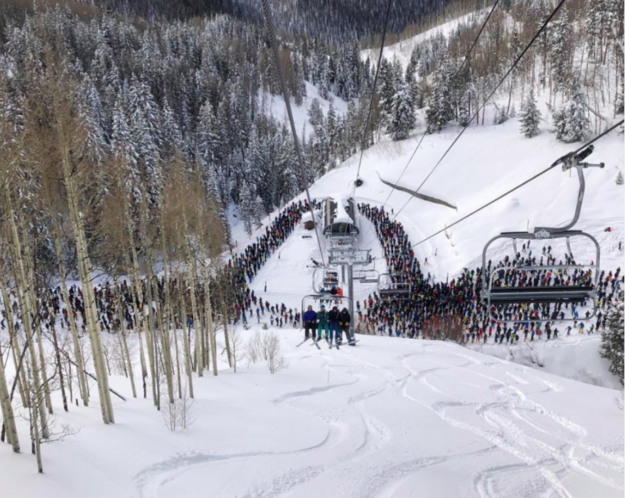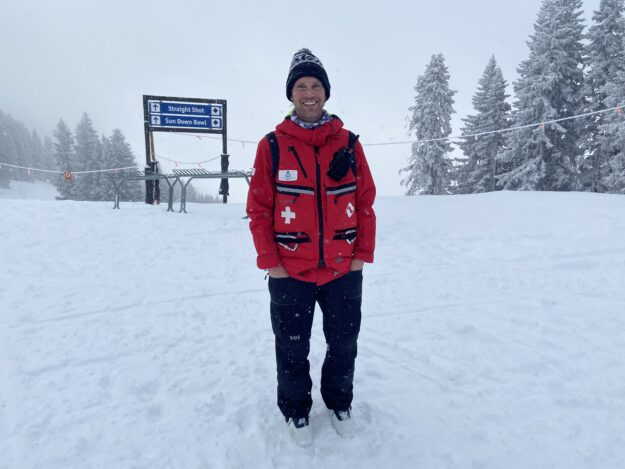Widgetized Section
Go to Admin » Appearance » Widgets » and move Gabfire Widget: Social into that MastheadOverlay zone
Democratization or ruination? A deep dive on impacts of multi-resort ski passes on ski towns like Vail

A massive Chair 5 lift line on a powder day at Vail in 2020 (Reddit photo).
Sadly, Mary Bono will always be synonymous with the dangers of skiing. Her globally famous former husband Sonny died in a ski accident at Lake Tahoe’s Heavenly ski area in 1998.
Mary and their two young children were skiing with Sonny – the 1970s global singing star with his former wife Cher – but lost him on the mountain, triggering a frantic search and a national outpouring of grief for the entertainer turned Republican congressman from Palm Springs.
Since remarried and a former California congresswoman in her own right after following in Sonny’s political footsteps for 15 years, Mary Bono is now a full-time resident of Durango, Colo., but she recently stopped skiing because of the physical dangers of the sport.

“It’s just a personal choice,” Bono said in a phone interview last fall. “But I’m unique because of Sonny’s accident. I’ve skied all these years since then, and he’s been gone over 25 years now … But I’ve separated a shoulder, I’ve broken my wrists, I’ve torn a bicep tendon, and I’m 63 next week. Life’s too short for me to be laid up because of a stupid injury. And when I inventory all of my injuries through my life, I used to think I was athletic; now I realize I’m just a klutz.”
But Bono also thinks skiing has become more crowded and therefore more risky over the last couple of decades with the advent of multi-resort season ski passes and changes in equipment.
“The photos out of Vail are epic. Epic Pass, oh my God, those crowds. Epic lines,” Bono said of crowding at major ski areas served by Vail Resorts’ Epic Pass and Alterra Mountain Company’s Ikon Pass – both Colorado companies. “Some of my friends who are great skiers have the Epic Pass and absolutely love it. I can just tell you that the equipment has gotten so advanced, it’s easier for bad people to ski longer and faster. By longer, I mean stay up, like they should have bit it halfway up the hill but they were able to stay up [and risk collisions].”
If she did still ski, Bono acknowledges her new home mountain of Purgatory – part of the independent, multi-mountain Power Pass — is often uncrowded and offers great skiing. And the growing popularity of smaller resorts like Purgatory may be a trend in the industry, experts say, with throwback ski areas regaining favor as the mega-resorts struggle with longer lift lines, parking and labor issues.
“So there really is a wonderful niche,” said Powderhorn part-owner Andy Daly. “We have way more terrain per skier … and people are more comfortable with that. When they experience the skier densities at Copper or Keystone or Breckenridge, that can be pretty intimidating on the weekends. And, particularly as people get older, they’re much more comfortable at resorts where the volume is lower and they don’t feel threatened as much by younger, faster skiers or riders.”
Daly is the former president and CEO of Vail Resorts and former Vail mayor who still lives in the company’s namesake ski town, but since parting with the Broomfield-based company, he bought in with the Gart brothers to the small ski area on Colorado’s Grand Mesa near Grand Junction that’s now managed by Park City’s Pacific Group Resorts.
“Small areas are driven from three perspectives,” Daly said. “One is cost, second is convenience and third, people that don’t care for the large areas. Lately, as the Epic Pass and Ikon Pass have gotten more expensive, for people with less discretionary income, it’s pushing them towards small areas, particularly if they have families.”
An early season adult season pass at Powderhorn is $429 and includes access to five other small ski areas around the country and in Canada. The pass climbs to $749 regular season, but the window price for a day ticket ranges from $89 most days to $109 on holidays.
By comparison, Vail Resorts’ adult Epic Pass started at $982 early season and peaked at $1,107 in December, offering unlimited access to 42 core resorts and up to seven days at 35 more resorts worldwide, but one-day lift tickets during the holidays rose as high as $329 at some Epic ski areas this season. Alterra’s early season adult Ikon Pass started at $1,249 and went up to $1,449 in December, offering access to 14 core resorts and up to five days at 39 more resorts.
Officials at Vail Resorts and Alterra Mountain Company did not respond to requests for comment for this story.
The multi-resorts season pass wars were first launched for the 2008-09 season by Vail Resorts when it introduced the adult, unlimited Epic Pass for just $579, leading to fears of brown-bagging, day-skier “riff-raff” overrunning resortswhere season passes previously cost as much as $1,800 a season as far back as the 1990s.
Some of those fears over parking congestion, traffic and skier safety have manifested in recent seasons with viral social media posts of lines at Vail and elsewhere, colossal traffic jams on Interstate 70 generating national news coverage, and stories of hit-and-run skier collisions becoming top of mind for snow riders.
This season, for the first time in the 17-year history of the Epic Pass, Vail Resorts sold fewer of them than the previous season – a 2-percent decrease from the 2023-24 season that was more than offset by price increases. Still, as the Storm Skiing Journal points out, “this is a potentially bad sign for a product that recorded double-digit growth for nine consecutive years from 2013 to 2021.” Can the decrease in pass sales from 2.4 million units to 2.3 million be viewed a sign the multi-resort pass model has reached a tipping point?
“Obviously, a certain amount of crowding is good because, wherever you are, you want your ski area to succeed; you don’t want it to fail,” observed John Norton, the former second in command at Aspen Skiing Company and top executive at Crested Butte who’s now a consultant working on economic development initiatives for Gunnison County. “And then there is a point, I think, where you get to enough is enough, and maybe some places have gotten there.”
But Norton adds that so many snow riders on the slopes today are “locals” who have relocated to the Colorado mountains as a lifestyle choice, or Front Range residents who have arrived in droves in recent year because they want to ski and climb mountains. And yet, Colorado has not seen a major new ski area built since Beaver Creek in 1981.
“You’ve had people move to all these valleys because they’ve become such nice places to live,” Norton said. “The schools are good, the hospitals are good. the skiing’s good, the fishing’s good, the entertainment’s great. That’s the transformation. And as it gets warmer and warmer in the Southeast and Southwest and remote work can happen, you see people looking at these ski valleys as a place to live. And then the Front Range is bigger. When I first moved here [in the 1980s], Denver really was kind of a cow town, and now it’s not like that at all.”
Dick Cleveland moved to Vail to work in law enforcement in the 1970s and was mayor of Vail from 2007 to 2011 when the Epic Pass was first introduced. He remembers daily lifts tickets for $18 and restricted season passes for just Vail and Beaver Creek for $1,800, or about $4,300 in 2025 dollars. Then came the $579 Epic Pass with unlimited skiing at five resorts in 2008.
“That was a game-changer for this community and for all their communities. It is half what it was 45 years ago,” Cleveland said. “The other side of that is look at the crowding on the mountain, and look at the crowding in Vail itself. The impacts on our community are huge, and Vail Resorts, because the mountain is in Eagle County, we don’t get any [sales] tax revenue from them.”
Cleveland said his last term on the town council he pushed for a lift tax increase but got pressured to drop the idea.
“I said, ‘No, you guys are doing nothing for this community. We need housing, we need parking, we need all of these things, and we’re getting nowhere with you,’” Cleveland said. “It ended up dying in the council; there wasn’t support.”

Current Vail Mayor Travis Coggin, who works in real estate planning and development and also as a part-time member of Vail Ski Patrol, said skiing is so much more accessible and affordable compared to when he moved to town as a kid in the late 1980s, which has empowered consumers with so many more options. The trick is balancing tourism with community needs, he added.
“The challenge that we have in our communities is to balance who lives here with who kind of subsidizes us living here,” Coggin said. “We’re not the target consumer of the advertising campaign … so trying to balance that out is a big thing that everyone’s going through is realizing that we’re all lucky enough to live in these communities because of these tourists.”
Increasingly, Coggin said ski towns are rallying to pay for workforce necessities, with local voters passing taxes in recent years for a regional transportation authority, a housing tax in the town of Vail and a housing tax for school district employees.
Neighboring Utah has seem many of the same issues in its ski towns.
“I just come from the school of thought that more people skiing is good,” Nathan Rafferty, the president and CEO of the trade group Ski Utah, said of the influx of Epic and Ikon passes in his state. “Are there challenges with people having such great access? Yeah, absolutely. And those solutions are … a little bit slower to come by because they involve stuff like infrastructure. Making a season pass cheap is a flip of a spreadsheet. Widening a road or a parking area or coming up with a new transportation plan is like a decade of red tape.”
Bill Jensen, a Vail resident who formerly helmed both Vail Resorts and rival Intrawest, is now a part-owner of independent Sundance ski area in Utah that isn’t on either the Epic or Ikon Pass. He said there’s no putting the multi-resort, affordable season ski-pass genie back in the bottle.
“I don’t see that model shifting; it’s been too successful, and it’s driven skier visits [nationally] well above the 60 million visit plateau that it achieved once in the first decade of the 2000s to multiple years above that,” said Jensen, who added smaller resorts are adjusting to the crowds that come with being part of the big multi-passes, limiting days and requiring reservations.
“So I see the industry trying to evolve and work through [all the issues],” Jensen said. “But I don’t think anybody could argue that Epic and Ikon Passes offer tremendous value to people who have the ability to ski and travel. I am very pro the excitement and energy and enthusiasm for skiing and snowboarding — not just Epic and Ikon, but all the pass products, even Sundance.”
An early season adult pass for Sundance cost $749 this season, but it included three complimentary days at throwback resorts in Colorado such as Cooper, Sunlight, Loveland and Monarch. Those smalls resorts and places like Bridger Bowl in Montana, Jensen said, are having success by creating a vibe that locals want to conserve.
“How do you build a relationship with your local community that provides them the experience that they’re seeking?” Jensen said. “And my comment about locals that complain about the crowds, [that vibe] is what they’re seeking. They just are living in the wrong place.”
Editor’s note: A version of this story first appeared in the Denver Gazette.
David O. Williams
Latest posts by David O. Williams (see all)
- Neguse, Bennet call for halt to BLM emergency rule aimed at increasing Utah oil-train traffic - June 23, 2025
- The O. Zone: Trump’s long list of broken campaign promises just jumped to yet another forever war - June 23, 2025
- The O. Zone: Coming to Vail this summer? Leave fireworks, risky fire behavior at home - June 20, 2025



Anne Marcum
February 13, 2025 at 12:09 pm
I live near Durango and stopped skiing 6 years ago at age 65 because the speeding snow boarders terrified me. The slow speed area funneling down to the lodge was not enforced even though there were volunteers standing right next to the slow skiing sign. At my age, if one of these speeders hit me, I could be seriously hurt. Sorry, Purgatory, you lost another season’s pass holder.
Biff Henderson
February 14, 2025 at 12:34 pm
The real focus shouldn’t be on crowding, but on how many of the local and area kids can afford to ski at Vail. This doesn’t make money, but it gives them the opportunities. Limit the adults, no matter how much they offer to pay.